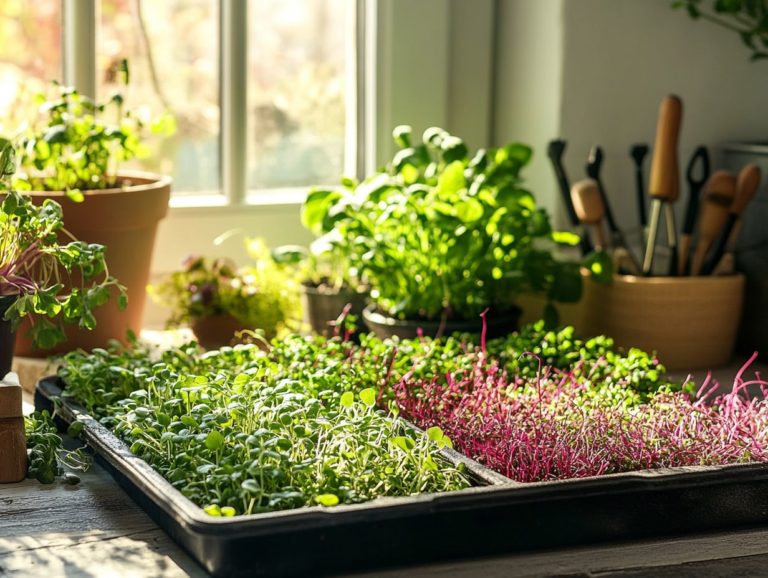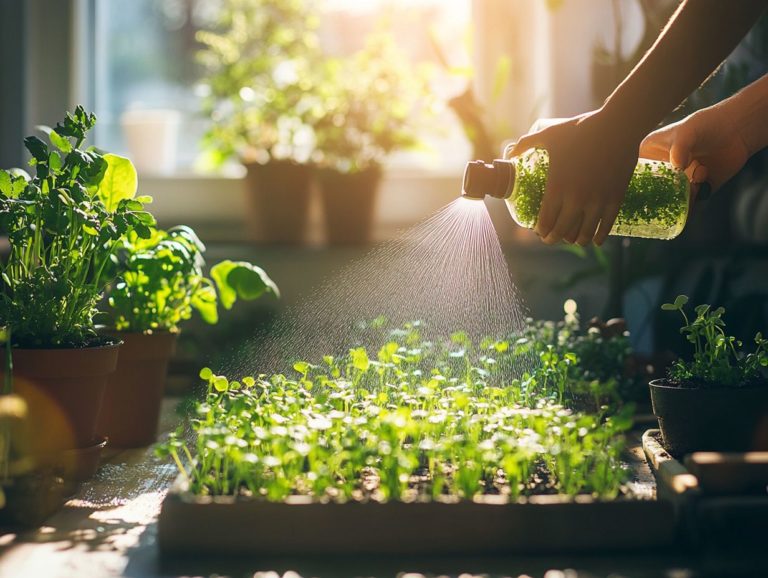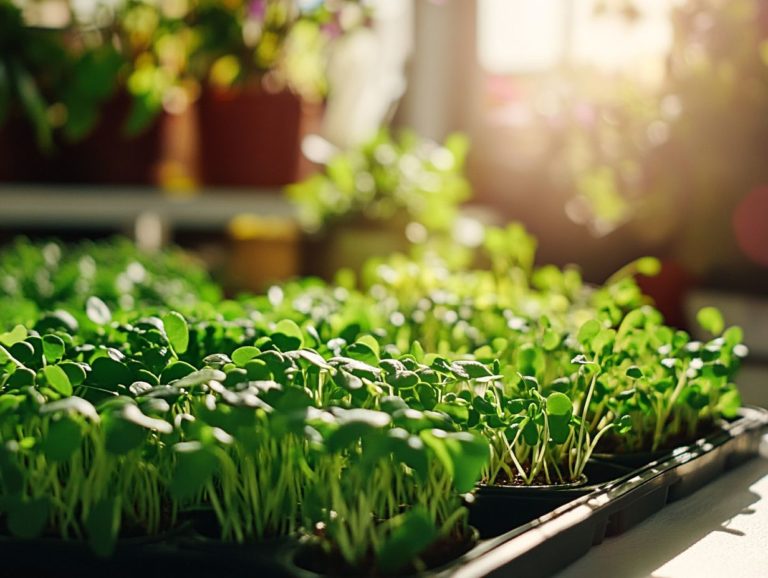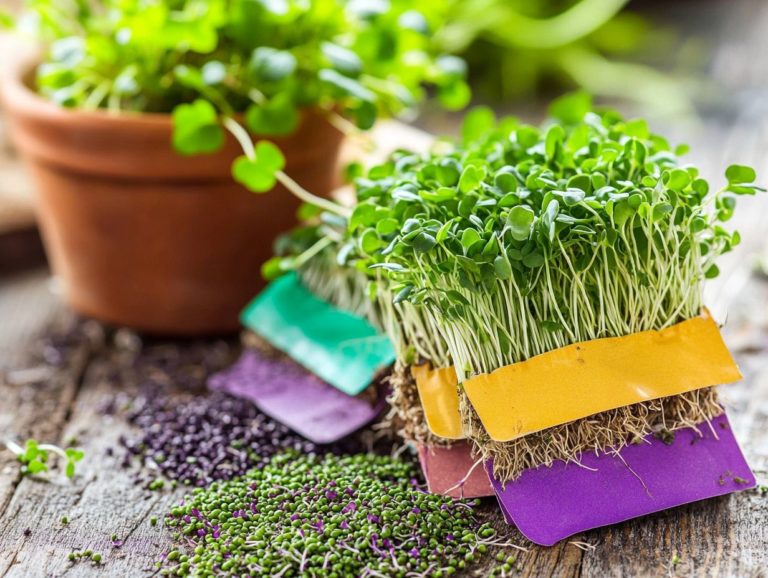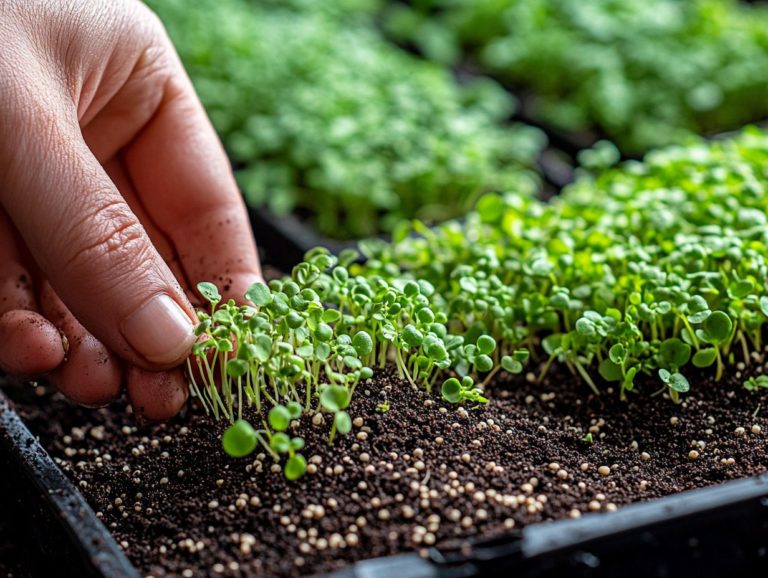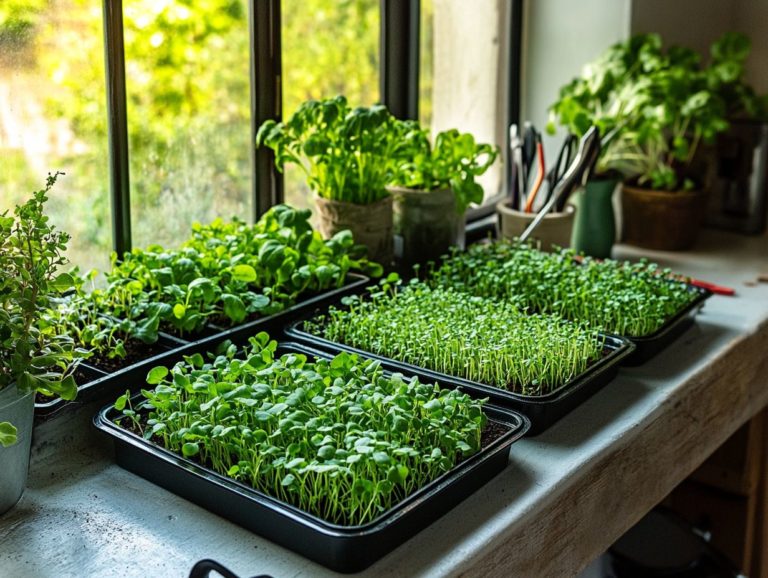Understanding Microgreen Growth Rates
Microgreens have taken the culinary scene by storm, not only for their striking flavors and vibrant hues but also for their remarkable nutritional advantages!
Whether you re an experienced gardener or just starting your journey, understanding microgreens and how to grow them is essential.
This article delves into what microgreens are, their myriad uses, and the key factors that influence their growth rates. You’ll find practical methods to monitor and enhance their development as well.
We ll tackle common challenges you might face along the way and offer solutions to ensure your microgreen garden flourishes.
Immerse yourself in this guide and discover how to unlock the full potential of these tiny powerhouses!
Contents
Key Takeaways:
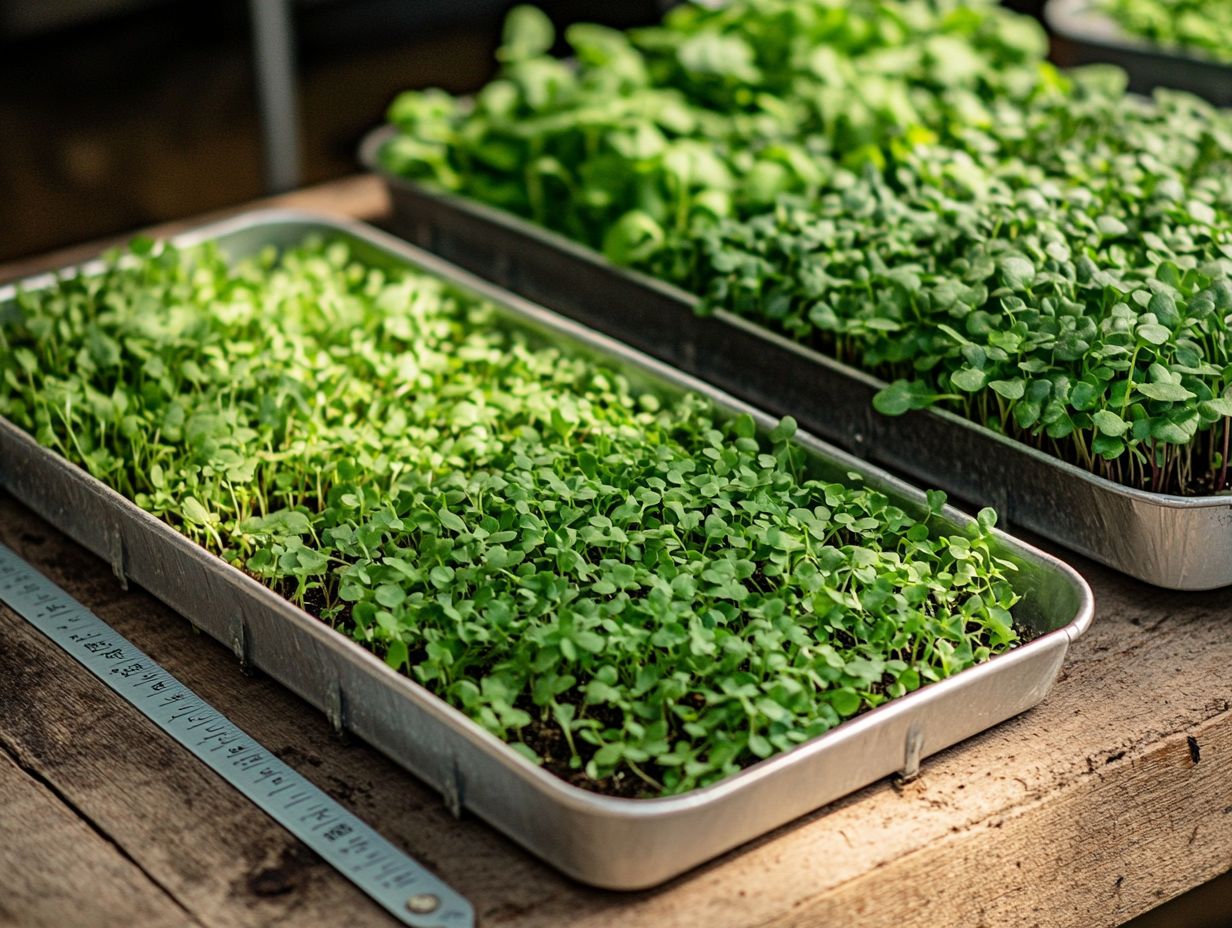
- Microgreens are young, nutrient-dense plants that are harvested after only a few weeks of growth. They are commonly used in salads, as garnishes, and in smoothies.
- The growth rate of microgreens can be affected by growing conditions, seed selection, and growing techniques. Factors such as temperature, light, and humidity play crucial roles in their growth.
- To optimize microgreen growth rates, monitor and measure their growth using tools and methods such as measuring trays and digital scales. Consistent watering, proper ventilation, and appropriate seed density can also improve growth and yield.
What are Microgreens?
Microgreens are the tender young seedlings of edible vegetables and herbs, harvested shortly after the first true leaves, or cotyledons, emerge typically around 7 to 21 days post-germination. These tiny powerhouses are packed with nutrients, providing a wealth of health benefits that make them a favorite not only in personal gardening but also in commercial sales.
As interest in sustainable food practices continues to rise, microgreens have found their place in community-supported agriculture, further enhancing the value of this burgeoning market.
Definition and Uses
Microgreens are the edible seedlings of various plants, celebrated for their intense flavors and vibrant colors. They are a top choice for both chefs and home cooks. Their charm goes beyond mere aesthetics; these tiny greens are powerhouses of nutrition.
Take amaranth microgreens, for instance. They not only bring a splash of color to your salads but also deliver a bounty of vitamins and minerals, including potassium and calcium. Chervil, with its delicate anise-like flavor, can elevate your dishes think soups and seafood while basil microgreens infuse a robust herbal essence, enhancing everything from pasta to pesto.
By incorporating a variety of these microgreens into your daily recipes, you can dramatically increase your intake of antioxidants and other beneficial compounds, making your meals both delicious and nutritious.
Factors Affecting Microgreen Growth Rates
The growth rates of microgreens can be shaped by a variety of factors, including growing conditions, seed selection, and the specific techniques you employ. Understanding these variables is crucial for maximizing your microgreens production effectively.
Knowing how each element interacts empowers you to cultivate the best possible harvest.
Growing Conditions
Growing conditions are key to successfully cultivating microgreens, with factors such as light exposure, temperature control, and humidity levels playing pivotal roles.
Choose the right growing medium to optimize growth, as this can significantly impact nutrient availability and moisture retention. Many cultivators gravitate towards soil-free options like coconut coir or hydroponic mats materials that allow plants to grow without soil which facilitate drainage and support robust root development.
Monitor temperature with precision, ideally maintaining a range of 65 to 75 degrees Fahrenheit; any deviations can stunt growth or invite disease. Humidity also deserves your attention; excessive moisture can foster mold, whereas insufficient humidity can lead to wilting.
Understanding these requirements helps you create the perfect environment for thriving microgreens!
Seed Selection
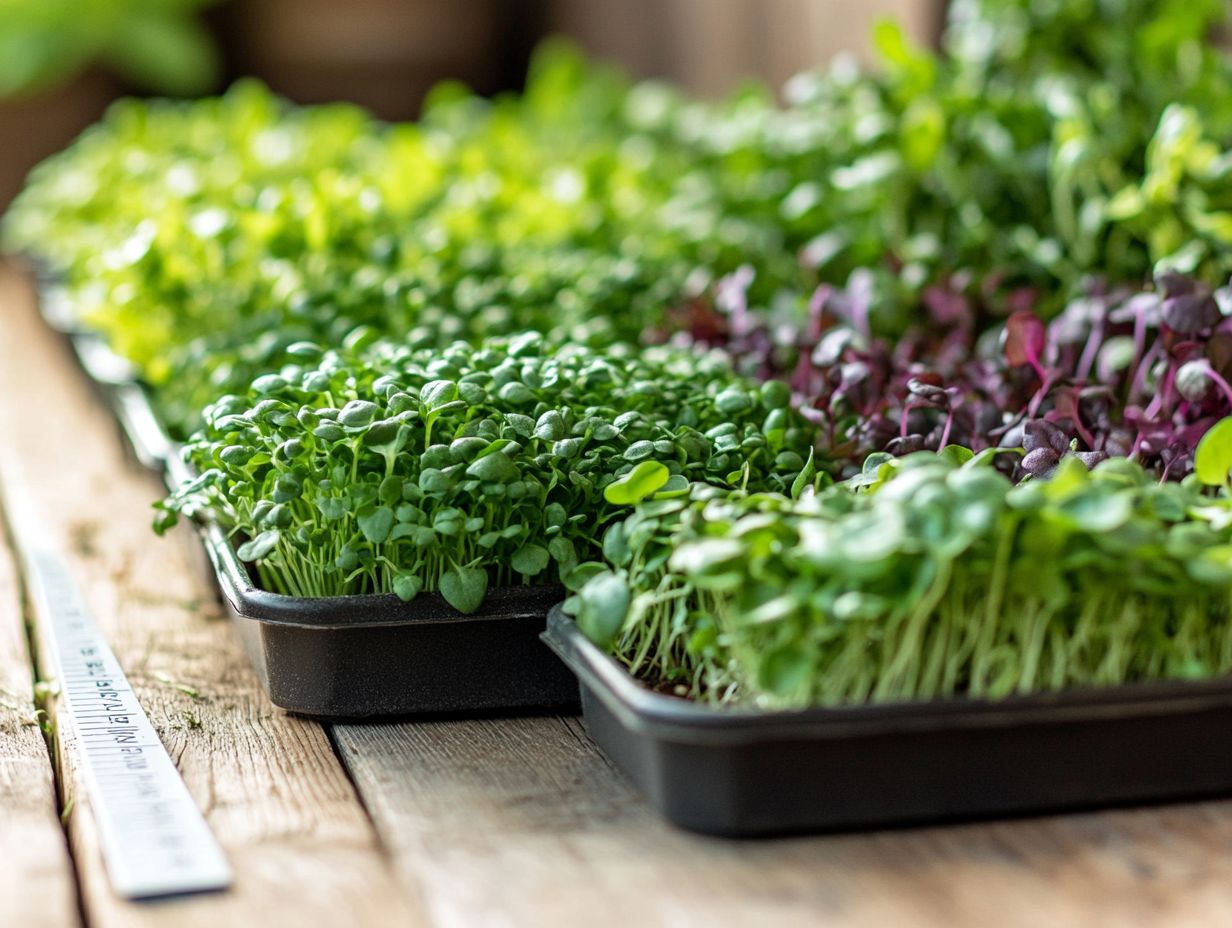
Choosing the perfect microgreens seeds can lead to amazing harvests, especially as the demand for microgreens continues to rise.
Opting for high-quality seeds enhances successful germination and significantly affects the flavor, appearance, and nutritional value of the microgreens you grow. To maximize freshness, it’s important to understand their longevity; check out understanding microgreen shelf life. Consider popular varieties like red garnet amaranth, radish, and basil, each bringing unique taste and texture to your meals.
Knowing how your seed choices affect germination helps you create better growing strategies that align with market demands for diverse and flavorful options. For those looking to enhance their understanding, understanding microgreen seed germination is essential. As consumer interest in these vibrant greens grows, selecting the right seeds can significantly boost both your yield and profitability.
Growing Techniques
Your choice of growing techniques for microgreens, whether soil-based or growing plants in water without soil, significantly impacts both the production cycle and overall yield.
Growing plants in water without soil allows you to cultivate using nutrient-rich water solutions that speed up growth rates through optimal nutrient absorption. This method often leads to more vibrant flavors and higher nutrient concentrations in your microgreens. To maximize your success, it’s crucial to understand the timing of microgreen harvest. However, be prepared for an initial investment in systems and the need for constant monitoring of pH (a measure of acidity or alkalinity) and nutrient levels.
Soil-based methods are more traditional and offer benefits like enhanced microbial activity and ease of use for beginners. However, you may encounter challenges such as soil-borne pests and inconsistent growth due to varying soil quality.
Ultimately, your choice of growing media plays a crucial role in determining the quality and yield of your harvest, so be sure to weigh your options carefully.
How to Monitor and Measure Growth Rates
Monitoring and measuring the growth rates of microgreens is essential for anyone looking to optimize yield and maintain quality. By using a range of tools and methods for precise assessment, you can elevate your growing practices and achieve exceptional results.
Tools and Methods for Tracking Growth
You have various tools and methods available to monitor the growth rates of your microgreens. This allows you to track progress and make informed adjustments as needed.
Among these, growth monitoring software is essential. It seamlessly integrates data collection with user-friendly dashboards that enable you to visualize trends over time. Simple metrics, such as measuring leaf height and density, provide immediate insights into the health of your plants.
For example, consistently checking leaf height can reveal optimal lighting conditions, while tracking density ensures that each microgreen has enough space to flourish. By using these tools effectively, you can identify critical patterns that relate to understanding the growth patterns of microgreen varieties, which, when adjusted, can significantly enhance your growing environment, ultimately leading to improved yields and a more successful harvest.
Optimizing Microgreen Growth Rates
Optimizing the growth rates of your microgreens requires implementing a carefully curated set of tips and techniques. These strategies are essential for enhancing both growth and yield, whether you’re cultivating for personal enjoyment or commercial purposes.
Get started with your microgreen garden today for delicious results!
Tips for Improving Growth and Yield
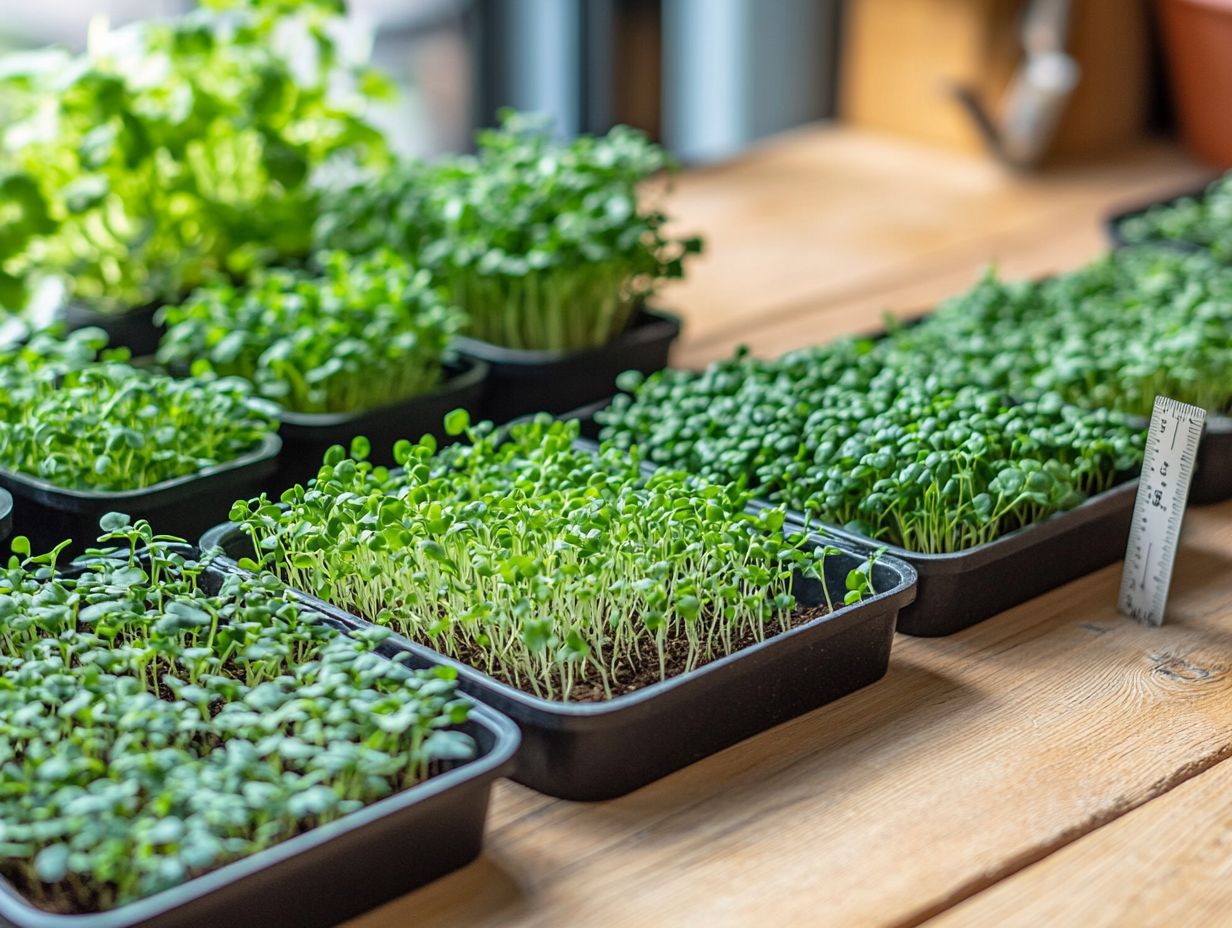
To enhance the growth and yield of microgreens, you can adopt several effective strategies, such as optimizing light exposure, ensuring proper watering, and maintaining ideal temperature and humidity levels.
By closely monitoring these crucial factors, you can cultivate a more favorable environment for your crops. Try using grow lights with the right spectrum! They can supercharge your microgreens growth. This process helps plants use light to make food.
Employing watering techniques like bottom watering not only prevents over-saturation but also encourages stronger root development. Keeping the temperature between 70-75 F and humidity around 40-60% can yield remarkable results, as these conditions closely mimic the microgreens’ natural habitat. Additionally, understanding microgreen harvest timing is crucial for optimal growth.
Insights from seasoned growers reveal that even minor adjustments in these areas can result in substantial increases in both the quality and quantity of your harvest.
Common Issues and Solutions
Common issues in microgreen cultivation can hinder optimal growth, but you can tackle these challenges head-on by employing smart problem-solving and implementing tried-and-true solutions.
Troubleshooting Common Growth Problems
Troubleshooting common growth problems in microgreens involves recognizing the symptoms and implementing effective solutions to ensure robust growth and optimal yields.
If you notice yellowing leaves, it might signal nutrient deficiencies, particularly a lack of nitrogen. To remedy this, consider applying a balanced fertilizer or enriching the soil with compost.
If you see mold, it may mean there s poor air circulation or excessive moisture. In this case, adjusting your watering practices or enhancing ventilation might be necessary.
Pests, like aphids, can also pose a threat to your microgreens, requiring you to turn to organic pesticides or natural predators such as ladybugs for effective control.
By sharing success stories from fellow growers who have overcome these hurdles like one who transformed a persistent mold problem into a thriving crop through savvy techniques you can gain valuable insights and encouragement on your own journey.
Frequently Asked Questions
What are microgreens?
Microgreens are young vegetable greens that are harvested just after sprouting. They are usually around 1-3 inches in height and are full of flavor and nutrients.
What factors affect microgreen growth rates?
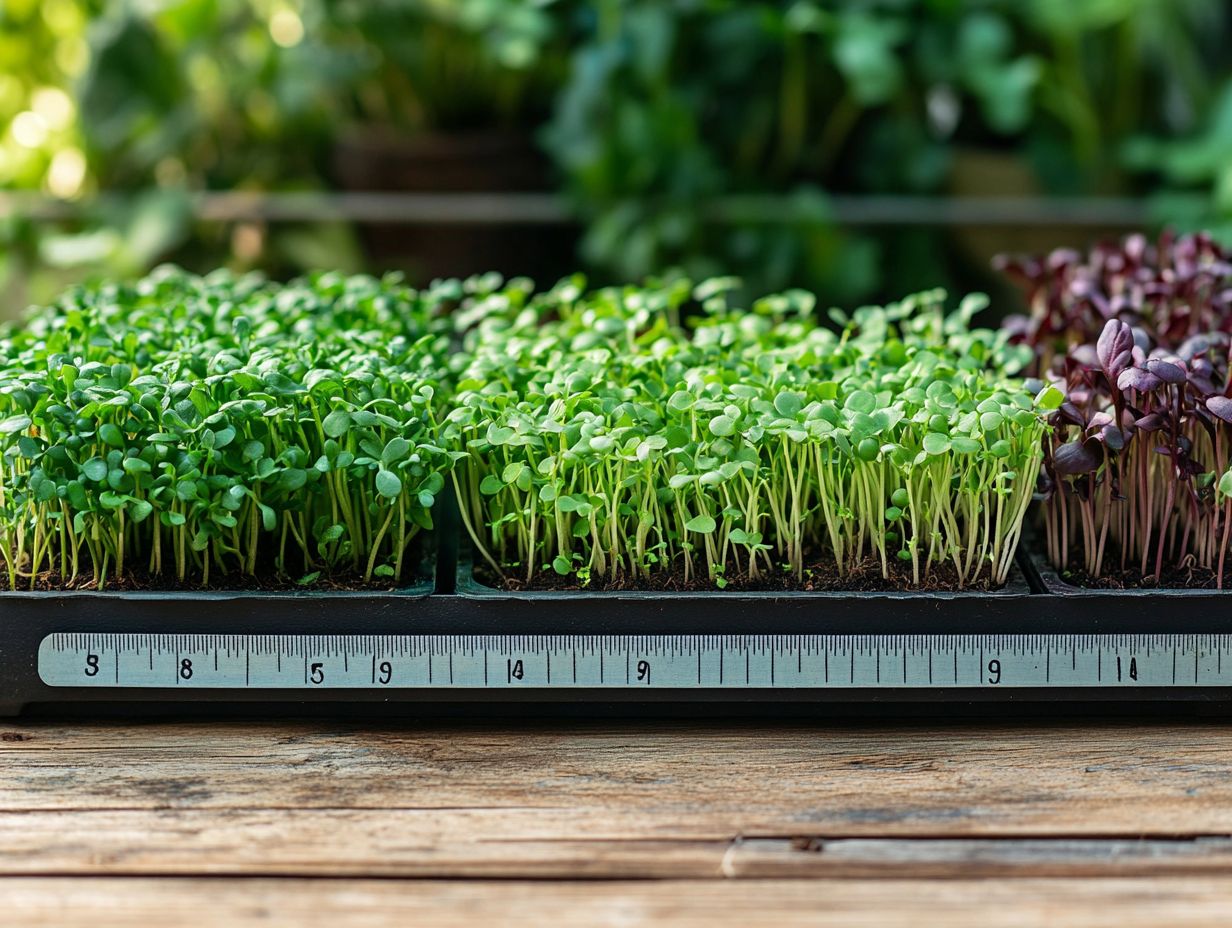
The growth rates of microgreens can be affected by several factors, including the type of seed, soil quality, temperature, water and light availability, and proper care and maintenance.
How long does it take for microgreens to grow?
The time it takes for microgreens to grow varies depending on the type of seed, but on average, they can be harvested in 1-3 weeks after planting.
What are the benefits of understanding microgreen growth rates?
Understanding microgreen growth rates can help you plan and time your harvests, ensure the best quality and flavor of your microgreens, and optimize their growth for maximum yield and nutrition.
What are some common mistakes people make when growing microgreens?
Some common mistakes people make when growing microgreens include overwatering, not providing enough light, using the wrong type of soil, and not properly ventilating the growing area.
How can I speed up the growth of my microgreens?
To speed up the growth of your microgreens, you can provide them with plenty of light, proper nutrition through fertilization, and regular watering. You can also use a heat mat to maintain a consistent temperature and promote faster growth.
Share your microgreen journey with us! What s worked for you?

